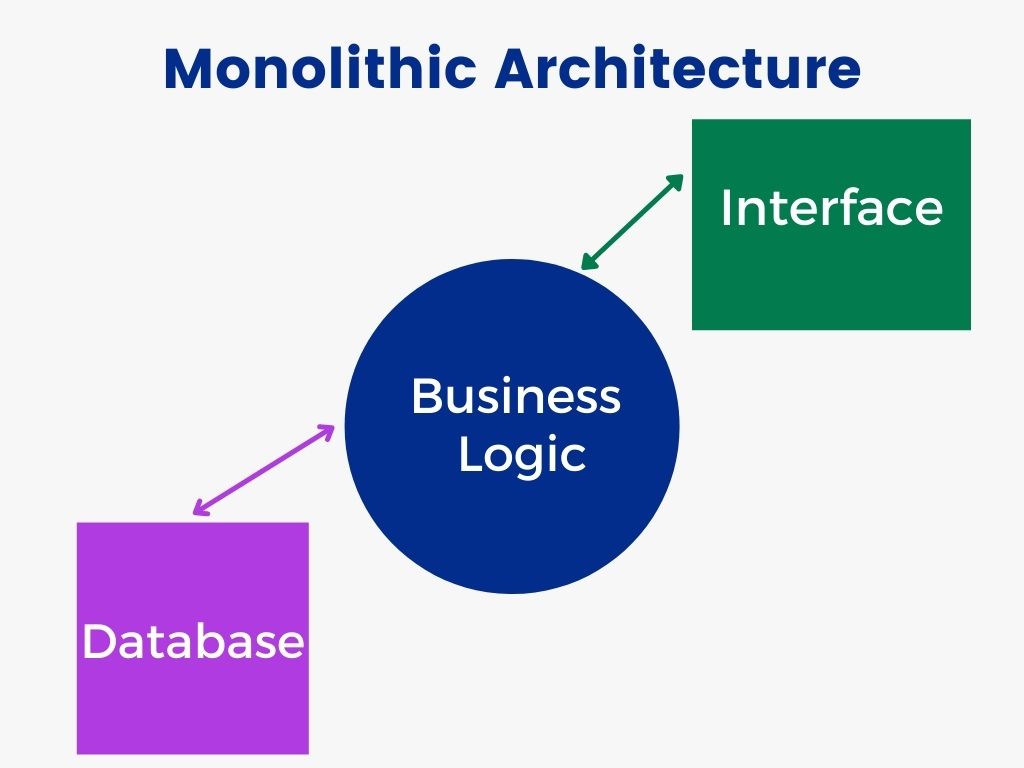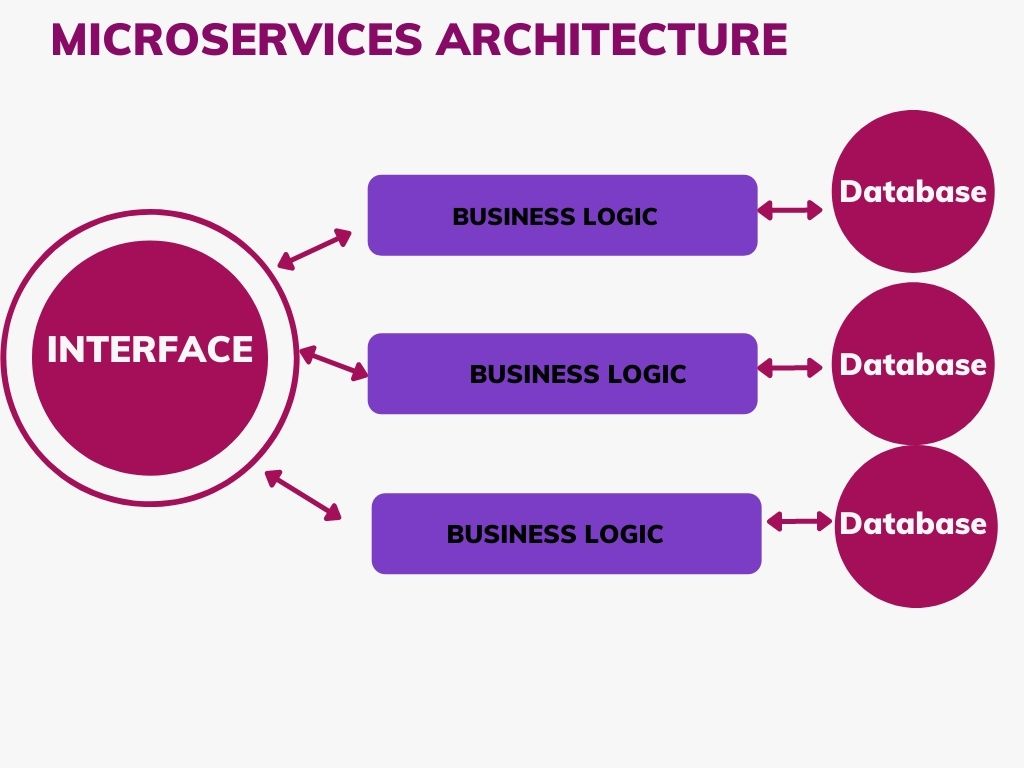Microservices vs. Monolith Architecture For SaaS
Even though many experts consider monolithic architecture as something outdated, controversy over the appropriateness of using microservices and monoliths has not stopped. It happens because each approach has nuances and can meet needs the others cannot fulfill.
So, this topic is not simple and plain. However, we can try to understand both architecture types' features and find a way to choose the right option for specific business purposes.
What Is Monolithic Architecture?
The software architecture that is built as an indivisible unit is called monolithic. It can include the server-side part, database, user interface and other components.
Because everything is in one block, all components are unified, and changes and maintenance happen in one place. Monolithic applications have a single large code base without any added modules. Therefore, changes and updates are made to the entire stack at once.
Monolithic architecture diagram

Advantages of the Monolithic Architecture
Monolithic architecture has its strengths that are worth noting.
- Monolithic applications are easier to deploy, as you only need to deploy one directory/file.
- Because monolithic solutions are traditional in software development, almost all engineers have the necessary knowledge and skills. You don’t need to look for developers who can identify and develop individual services.
- Such applications have fewer cross-cutting concerns related to caching, processing, performance monitoring, etc. Since all these things are tiring for one unit, working with them is easier.
Also, monolithic solutions allow end-to-end testing much faster, as they are an indivisible unit. It makes debugging and resolving security or delay issues much more accessible.
Disadvantages of Monolithic Architecture
The main disadvantages of such architecture follow from the monolithic structure.
Slow development cycle due to the large codebase
The extensive code base with the development of the application becomes even larger. If new engineers join the project, they need more time to get acquainted with the logic and details of the application. Therefore, the speed of the development and testing cycle may slow down.
Difficulties with horizontal scaling
Because all application components are in one block, horizontal scaling is impossible. You will have to redeploy the program completely, even for minimal changes. And you definitely have to consider this issue while planning your product budget.
Challenging updating
Implementing new technologies in monolithic structures is challenging because it affects all levels of the program, not specific functions. So it could take a lot of time to adopt the technology properly and ensure no mistakes. Minimal failure can disrupt the entire app.

Monolithic Software Use Cases
Monolithic application architecture is a good choice when:
- You need simple software. Small and non-complex apps don’t require complicated logic, high scalability, special hierarchy. It’s better to use monolithic architecture for such cases as document syncing platforms, management apps, etc.
- You have a small team without expertise in microservices. For startups with a small team, microservice architecture can be unnecessarily complex and expensive for startups with a small team. In such cases, a monolithic model can meet all business needs without wasting time.
- You're developing an app with a complex domain. Programs with tangled domains can suffer from breaking a complex system vertically (like it happens with microservices). In this case, monoliths will be a slightly better solution.
- You have strict time limits and must launch the product fast. The monolithic model is perfect when you need to cut costs at an early stage.
This option is also a good solution for applications prioritizing CPU/network throughput or latency and faster response. The most illustrative monolithic application examples can be an automotive, courier, telecommunications apps, etc.
What Is Microservices Architecture?
In the 2010s, fast-growing companies such as Netflix, Spotify, Amazon, Uber, etc., faced the fact that monolithic architecture and service-oriented architecture (SOA) could no longer provide the required speed and quality of their scaling. So there, a new way to think about structuring applications appeared – microservices.
Microservice architecture approaches software development as a set of small services. Each service runs in its own process and interacts with lightweight mechanisms, often HTTP resource APIs.
Some believe this approach is a new service-oriented architecture (SOA) version. Others, such as Dijiang Huang and Huijun Wu, believe that microservices and SOA differ in implementation examples, architectural style, and even related technologies but play similar roles in the tech landscape.
The main difference between monolithic and microservices architecture is that the second one is created considering the product's business capabilities and can be deployed independently due to the automated deployment mechanism. It means that centralized service management is minimized, and the services themselves can even be written in different programming languages and using different technologies. That’s why you can update, deploy or scale every service independently, and it covers its own scope.
Microservices architecture diagram

Advantages of the Microservices Architecture
The main advantages of microservices over monolithic are flexibility and complete independence.
- You can update and redeploy each service separately, which reduces startup time.
- You can use different technologies for particular services depending on individual business requirements.
- In case of error or breakage, the failure of one microservice doesn’t affect other components and the whole system.
Other benefits of microservices are simple understanding and low risks. Because the program is divided into smaller components, its logic is easier to understand. Such products are also more manageable and trouble-free for new developers for the project onboarding.
Such microservices principles as dividing into smaller functional parts also reduce errors' risks and consequences.
Disadvantages of the Microservices Architecture
The primary disadvantage of microservices is the additional complexity of the system and infrastructure. All microservices and databases need proper selection and connection configurations, and the app complexity increases with its scaling and adding new features.
- Special qualifications are required. Developers can more easily understand the application's logic, but they must have specific expertise in working with microservices.
- Cross-cutting issues. Cross-cutting issues are divided into separate microservices, like the whole program. These can be difficulties with metrics, external configurations, etc.
- Lower security and higher cost. Microservice apps have a lower level of protection because communication between services takes place over a network. It increases the load on the network, and remote calls for interaction between microservices lead to delays.
Microservice design is also more challenging to test, as all components are deployed independently, complicating the verification and debugging process.
Microservices Software Use Cases
As mentioned above, giants like Netflix, Spotify, Amazon, and Uber started as monolithic products and gradually switched to microservices.
This architecture style could be a perfect solution if your goal is not just to update the software but also to scale it significantly to meet different business needs. This approach allows you to add new features and experiment with advanced technological solutions effortlessly and fast.
Working with microservices requires a team of developers with experience with Azure Kubernetes, as well as DevOps and Containers experts. So, microservice architecture will be the best option in case of sufficient team expertise, large-scale project, and plans for its significant expansion.
Our best example of microservices projects is an email template visual builder with AMP support. As it has wide functionality and we have to improve and expand it constantly, the best decision was to choose this kind of architecture.

Microservices vs. Monoliths Deployment Strategies
The monolithic architecture has three levels and can be easily deployed on various web servers (IBM Websphere, Apache Tomcat, etc.). In this case, developers use a traditional deployment scheme.
As for microservices vs. monolith, the choice of deployment strategies is wider.
One Service – One Host
This strategy involves deploying different services on one virtual machine (host). The “One service – one host” approach minimizes infrastructure costs and simplifies software maintenance, and this is the most simple and plain option.
One Service – One Container
This option involves traditional HTTP servers and the deployment of services in containers. The process requires knowledge of Docker and Kubernetes.
Proper containerization allows you to isolate services and protect them from errors and failures completely. Because the services are hosted on the same machine, this approach reduces the infrastructure cost. However, horizontal scaling can take some time, depending on process optimization.
Serverless Deployment
The serverless approach is a fairly common solution that allows you to deploy without a server. The most famous examples of this approach are AWS Lambda, Google Cloud, Azure.
In this case, servers for maintenance, OS for support, etc., are not used. The state is managed through databases or different storage. The lambda function launches microservices and processes all requests.
Microservices vs. Monoliths Comparison: What Is Better?
Talking about the monolithic architecture vs. microservices architecture, we should consider cost, reliability, scalability, time to market, throughput and complexity.
Cost
Cost assessment includes many components: maintenance, deployment, development, speed, performance, scaling, and more. Therefore, each application should be considered separately.
On the one hand, the need for additional services or units equals an additional cost. On the other hand, in the case of monoliths, scaling, new technologies adoption and updating take place within the whole system, which is also quite expensive.
In general, the cost of monolithic applications in most cases is higher. However, we should not forget that there may be exceptions, depending on software type and business needs.
Scalability
With the exact cost of resources for scaling, microservices can provide more throughput and more accurate scaling. Processing more connections to scale a monolithic application using all available resources is difficult. To do this, you must bring up a second instance. In comparison, only instances of specific services are needed for microservices under the same conditions.
Therefore, microservice containers can be scaled better with less resource use.
Reliability
Regarding the reliability of calls, the monolithic architecture is the winner. All calls are local, significantly reducing network failure risk, while microservices have long call chains that increase the risk of error on each new iteration.
However, there are some nuances. Service meshes such as Istio or Spring Cloud solutions handle failures and balance the load.
Thus, if the service in the cluster doesn’t work, it can be replaced, or the virtual machines can be terminated. In the case of monoliths, any problem affects the entire system's operation and the software as a whole.
So, the issue of reliability depends on the goals, scale and implementation of the software. Modern microservices are adapted to the possibility of failure, and monolithic apps of certain types don’t even need such an adaptation.
Time to Market
Time to market is the period from making a business decision to the beginning of the public product operation. In this case, microservices are better for many reasons.
- Monoliths are large, and it’s challenging to deploy them quickly. In comparison, microservices can be deployed gradually and continuously as the consequences of such changes are localized.
- When deploying microservices, you can change individual implementations without changing dependent services. It’s also worth noting that this architecture is perfect for scaling and transferring from the old version to the new one.
- Microservices have fewer dependencies and are easier to test.
Thus, microservices win in the case of microservices vs. monolithic architecture time to market.
Complexity
While building and developing microservice architecture, the code base's size increases and becomes more diverse. Often developers use different source codes, programming languages and technologies. The code may be duplicated because the microservices must exist separately.
For example, using the Kubernetes cluster provides automatic scaling but complicates the management process. Out-of-service data synchronization requires extraordinary effort and control.
At the same time, the monolithic architecture is easy to manage and rarely has duplicate code. Of course, it’s more challenging to understand the logic of the whole project in such cases. However, it is a bit easier to operate.
Throughput
In the case of microservices, data is transferred between different services. The more services, the greater the load and cost of infrastructure. Therefore, monoliths provide better performance and throughput. Monolithic architecture is a must for non-distributable workloads where performance is the priority.
So the conclusion is that the choice depends on your product's individual features and needs. Microservices have a faster time to market, are easier to scale, and allow you to adopt new technologies and make changes quickly. However, monoliths may be more reliable and manageable.
How Do Software Development Processes Differ Between Microservices and Monolithic Architecture?
Working with monoliths has its nuances. It is essential to ensure that the codebase doesn’t become chaotic and that developers understand the software logic and its architecture. Therefore, all actions must be properly coordinated, and operational flexibility is difficult to achieve. As for testing, the team can perform end-to-end tests.

The approach to microservices development is different. Developers use API control capabilities and a variety of deployment/integration technologies. All services are independent and managed separately, so ensuring they are small and easy to operate is essential. They can be reused without a direct connection from shared libraries, and one artifact can be scaled independently of other services.
Thus, each team member has his/her own area of responsibility. They don’t have to understand the logic of the whole project to implement the necessary functions, update, manage and deploy a particular service. Testing requires tests for each component individually.
For the development and maintenance of monolithic software, team members should have skills in some of the following stacks: Python/Django, .NET, JavaScript/Node, Java, Ruby, Python/Django, PHP. For microservices important to master DevOps, Docker, Kubernetes, Lambda, etc.
How to Migrate From Monolithic to Microservice?
Every app goes through several stages of migration to switch from a monolithic architecture to microservices. This process looks like migration from a traditional app to SaaS in some ways.
Of course, each product has individual features and purposes that affect the transition process. We can only describe an approximate development picture. However, the generalized process includes the steps described below.
Step 1. Build
Traditional monolithic architecture often has an outdated design that needs significant changes. That is why optimizing it before migrating is crucial – identify and remove all factors that affect the build and the whole architecture, identify and reorganize individual components, etc.
Step 2. Dependencies
When the build is optimized, it is necessary to determine the dependencies between the components. Typically, developers use various static source analysis tools to find calls between different data types, libraries, etc.
You can also use dynamic analysis tools for this purpose, which do the same thing but during program execution. After that, the modular dependencies of the monoliths are decoupled.
Step 3. Development and Infrastructure Adoption
At this stage, developers prepare a local environment to create, deploy, and test software. All processes, including the performance of operational tasks, occur at a faster velocity here.
Then, most often, branches are created in the code repository for all microservices. This way, developers increase the software development lifecycle (SDLC) agility. It also helps save all the features of a distributed monolith.
After that, you can move on to the infrastructure as a code (IaC ) adaption, which helps achieve greater consistency and unification. After removal, components, data objects, functions, etc., should be divided into microservices depending on the purpose and features. Each microservice performs a particular set of actions, has its own data storage and operates objects within this datastore.
Step 4. Testing and Deployment
At this stage, the developers check all services, functions and calls, remove outdated data from moved datasets, update access control, etc. The deployment process begins after testing is completed and the remaining monolithic code has access to new services and no connections to the old datastore.
Final Thoughts
Monolithic and microservice architectures are very different and suitable for different needs. Monolithic solutions are traditional, so they don’t require special technical expertise. Due to the inseparable code base, the number of errors and security holes is smaller, but each error affects the entire software.
Microservices allow you to achieve extensive functionality and regular updates but require specific knowledge to create and maintain. It is also more challenging to test such software because it is necessary to check each service and component.
Thus, the choice of architectural approach depends on many individual factors, such as the purpose of the application, the need to add features regularly, etc. It’s essential to consult with specialists and conduct an in-depth analysis to avoid the mistakes mentioned in our previous article. We’ll happily answer all your questions and find the best solution for your product.
F.A.Q.
Should I start with a microservice or a monolith?
It all depends on your software goals, budget and needs. Some experts advise starting with microservices because they’re more flexible and allow you to implement new technologies effortlessly. However, many developers have recently offered a monolithic architecture for specific cases. Therefore, the choice should be made based on professional analysis.
How to convert monolithic to microservices?
Every software is unique, and it requires a special approach. We’ve talked about the approximate stages of this kind of migration, but we can see the whole picture only after in-depth analysis. So we’ll be pleased to provide you with any consultation. You can also find more information about app re-architecting here.
Do microservices require a specific technology stack?
Yes, it requires skills in DevOps, Docker, Kubernetes, Lambda, etc.
